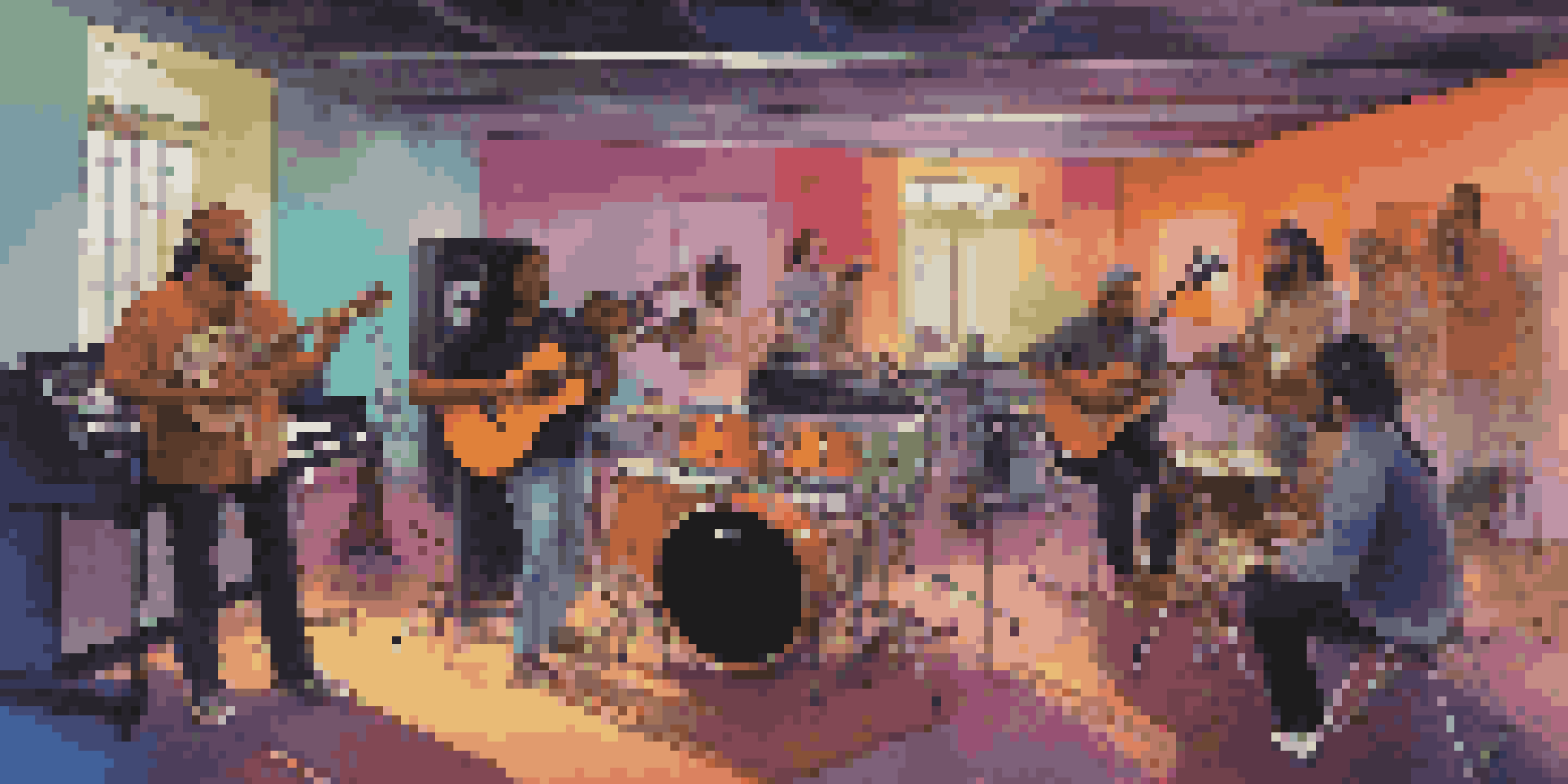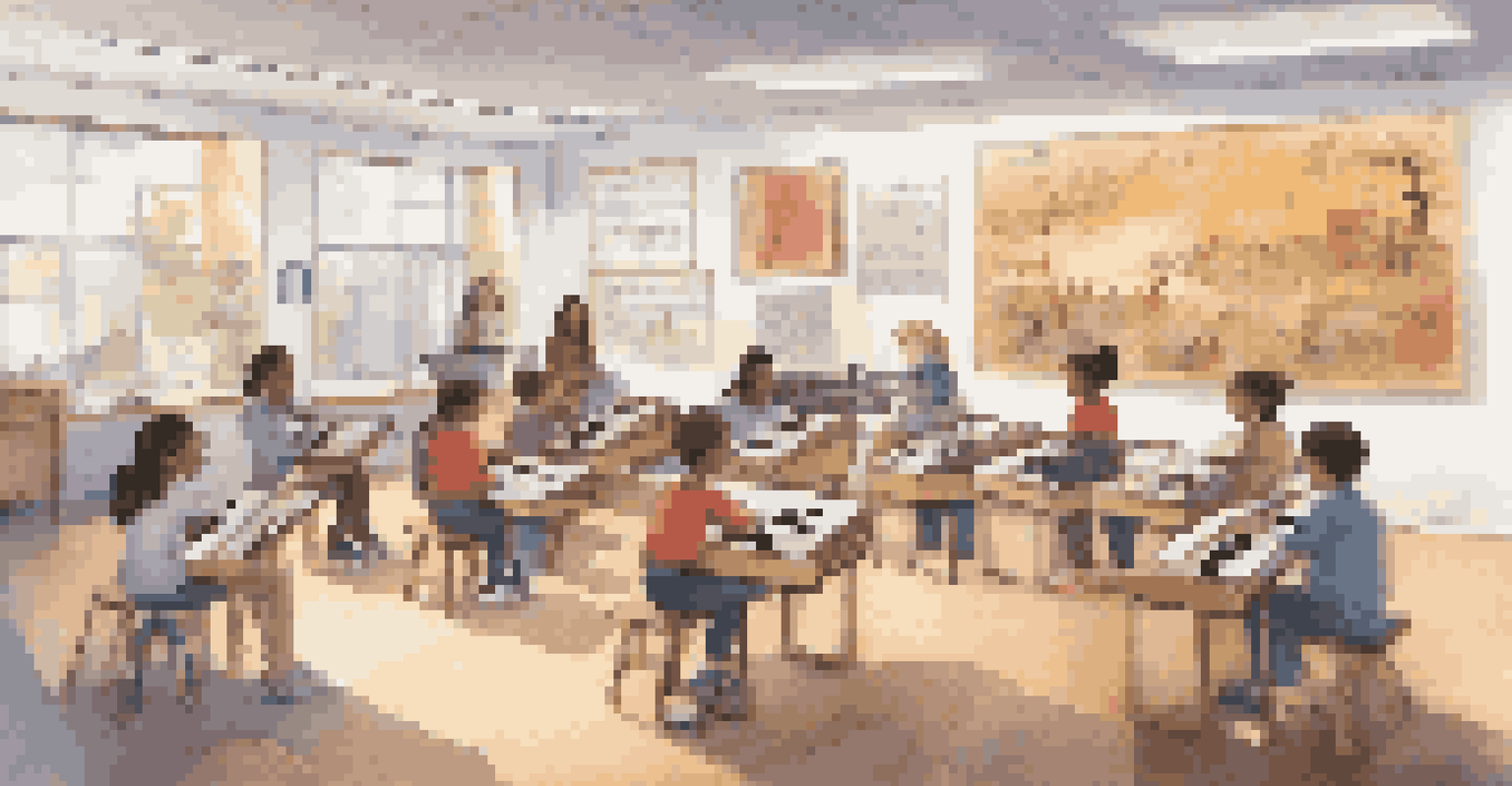The Impact of Music Technology on Cultural Exchange and Fusion

Understanding Music Technology and Its Evolution
Music technology encompasses tools and innovations that enhance the creation, production, and distribution of music. From vinyl records to digital streaming, technology has continuously reshaped how we experience sound. Today, advancements like artificial intelligence and virtual reality are taking music to new heights, making it more accessible and interactive than ever before.
Music is the universal language of mankind.
These technologies not only change how artists create music but also how listeners engage with it. For instance, platforms like Spotify and SoundCloud allow emerging artists to reach global audiences, breaking down geographical barriers. This democratization of music has opened doors for diverse voices and styles, enriching the cultural landscape worldwide.
Moreover, as technology evolves, it encourages experimentation and fusion in music. Genres that were once distinct are now blending seamlessly, creating innovative sounds that reflect a fusion of cultures. This evolution underscores the dynamic relationship between music and technology, setting the stage for deeper cultural exchanges.
The Role of Digital Platforms in Cultural Exchange
Digital platforms have revolutionized the way we access and share music, facilitating cultural exchange like never before. With a simple click, listeners can explore music from various cultures, broadening their musical horizons. This accessibility fosters a greater appreciation for different traditions and styles, paving the way for cultural fusion.

Social media platforms play a crucial role in this exchange, enabling artists to share their music with a global audience. For example, TikTok has become a powerful tool for promoting diverse sounds, with viral trends often originating from non-Western music. This exposure helps to normalize cultural diversity in mainstream music, encouraging collaboration and innovation.
Music Technology Enhances Cultural Exchange
Advancements in music technology have made it easier for artists to collaborate across borders, fostering cultural fusion and diverse musical expressions.
As artists from different backgrounds interact online, they inspire each other and create unique blends of genres. This collaboration highlights the interconnectedness of our global music community, demonstrating how technology can bridge cultural divides and foster mutual understanding.
Collaboration Across Borders: A New Era of Music Fusion
Music technology has made cross-border collaboration easier, allowing artists to work together regardless of location. Tools like video conferencing and cloud-based software enable musicians to create and record tracks in real-time, even if they are thousands of miles apart. This not only enhances creativity but also results in innovative music that reflects multiple cultural influences.
Technology is best when it brings people together.
Consider the rise of genre-blurring collaborations, such as when hip-hop artists team up with traditional musicians from different cultures. These partnerships result in fresh sounds that resonate with diverse audiences. By marrying different musical elements, artists can create something entirely new while paying homage to their roots.
Such collaborations not only enrich the artists' individual styles but also create a dialogue between cultures. They foster a sense of global community, reminding us that music is a universal language that transcends borders and unites us through shared experiences.
The Influence of Streaming Services on Global Music Trends
Streaming services have transformed how we discover and enjoy music, with algorithms curating playlists that expose listeners to an array of global sounds. This has led to a surge in popularity for genres like K-pop, Afrobeat, and Reggaeton, showcasing the power of technology to amplify cultural voices. As listeners embrace these diverse genres, they contribute to a more inclusive music industry.
Additionally, playlists that feature a mix of musical styles encourage audiences to explore unfamiliar sounds. This exploration fosters a deeper understanding of different cultures and traditions, as music often reflects the stories and values of its origin. In this way, streaming services act as cultural bridges, connecting people through shared musical experiences.
Streaming Services Drive Global Trends
Streaming platforms have transformed music discovery, promoting genres from around the world and encouraging listeners to explore unfamiliar sounds.
The impact of these platforms extends beyond just music consumption; they also influence how artists create and market their work. As musicians recognize the potential of global audiences, they may incorporate diverse influences into their music, further driving cultural fusion and exchange.
Music Technology in Education: Fostering Cultural Awareness
Music education has also benefited from advancements in technology, providing students with tools to learn about and engage with diverse musical traditions. Online courses and digital resources make it easier than ever for aspiring musicians to explore different styles and cultures. This access encourages a new generation of artists to incorporate varied influences into their work.
Moreover, technology allows for immersive learning experiences, such as virtual reality music lessons that transport students to different cultural settings. These experiences can deepen their understanding of music's role in various societies, fostering empathy and appreciation for cultural diversity. As students learn to create and perform, they also develop their identities as global citizens.
By integrating technology into music education, we can cultivate a sense of cultural awareness and respect. This foundation not only enriches students' musical journeys but also empowers them to contribute to a more inclusive and harmonious world.
The Challenges of Cultural Appropriation in Music
While music technology facilitates cultural exchange, it also raises important questions about cultural appropriation. This occurs when artists borrow elements from a culture without understanding or respecting its significance. As genres blend and evolve, it's crucial to navigate these complexities mindfully to ensure that cultural exchanges are respectful and authentic.
For instance, when a pop artist incorporates traditional instruments from another culture, it can be seen as a celebration of diversity or as appropriation, depending on the context and intent. This distinction is essential in fostering healthy cultural exchanges where artists honor the roots of the sounds they borrow. Open dialogue and education are key in addressing these nuances.
Education Promotes Cultural Awareness
Technology in music education provides students with access to diverse traditions, fostering empathy and cultural appreciation among aspiring musicians.
Artists and listeners alike have a role to play in promoting cultural sensitivity. By supporting artists who engage with other cultures respectfully and authentically, we can encourage a music landscape that values collaboration over appropriation. Ultimately, this approach enriches the cultural tapestry of music while maintaining integrity.
The Future of Music Technology and Cultural Fusion
As technology continues to evolve, the landscape of music fusion and cultural exchange will only expand. Innovations such as artificial intelligence and machine learning are already beginning to shape how music is created and consumed. These advancements hold the promise of even more diverse and unique musical expressions, as algorithms analyze and combine elements from various traditions.
Additionally, as virtual and augmented reality technologies become more mainstream, they may offer immersive concert experiences that showcase global music in new ways. Imagine attending a live performance that transports you to different cultural settings, enriching your understanding of the music being performed. This could revolutionize how we experience and appreciate music from around the world.

Ultimately, the future of music technology is bright and full of potential for cultural exchange. By embracing these changes and fostering collaboration across borders, we can create a vibrant musical landscape that celebrates diversity and unity, resonating with audiences everywhere.